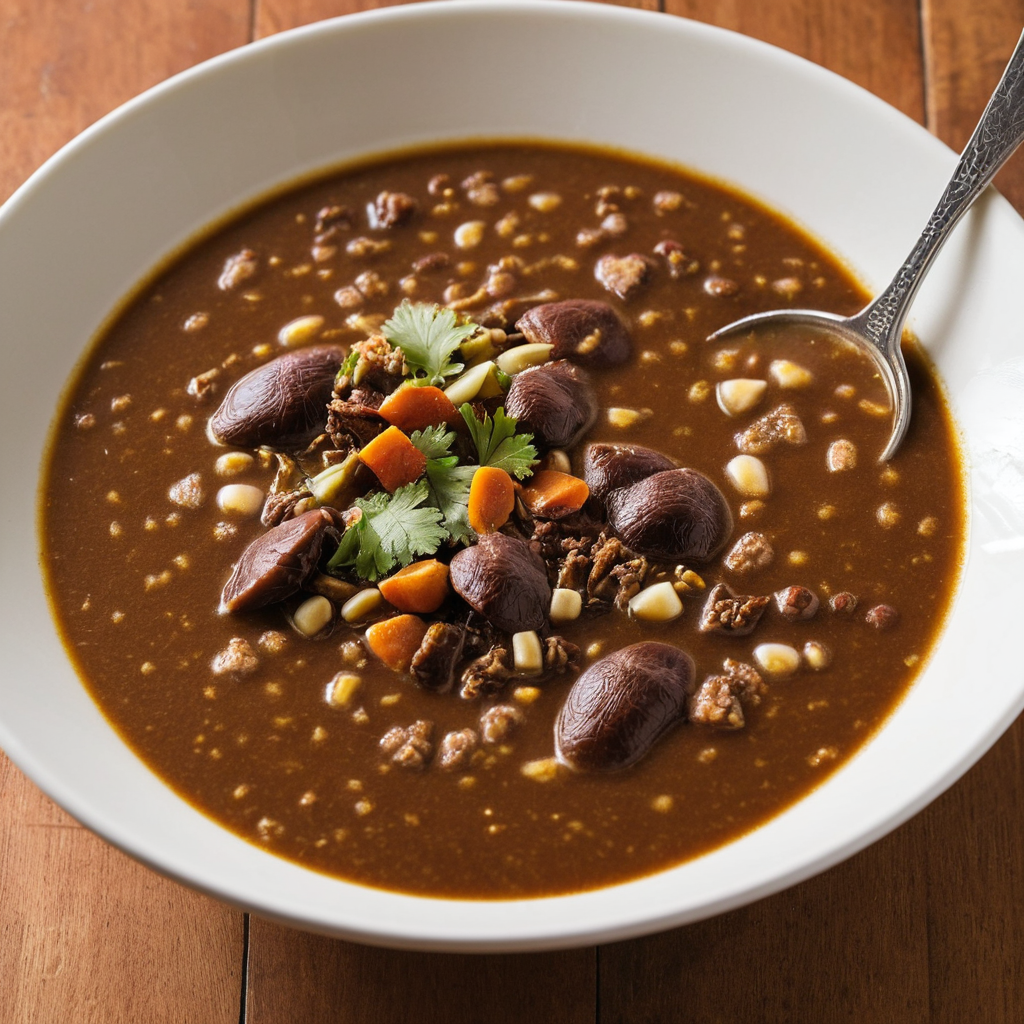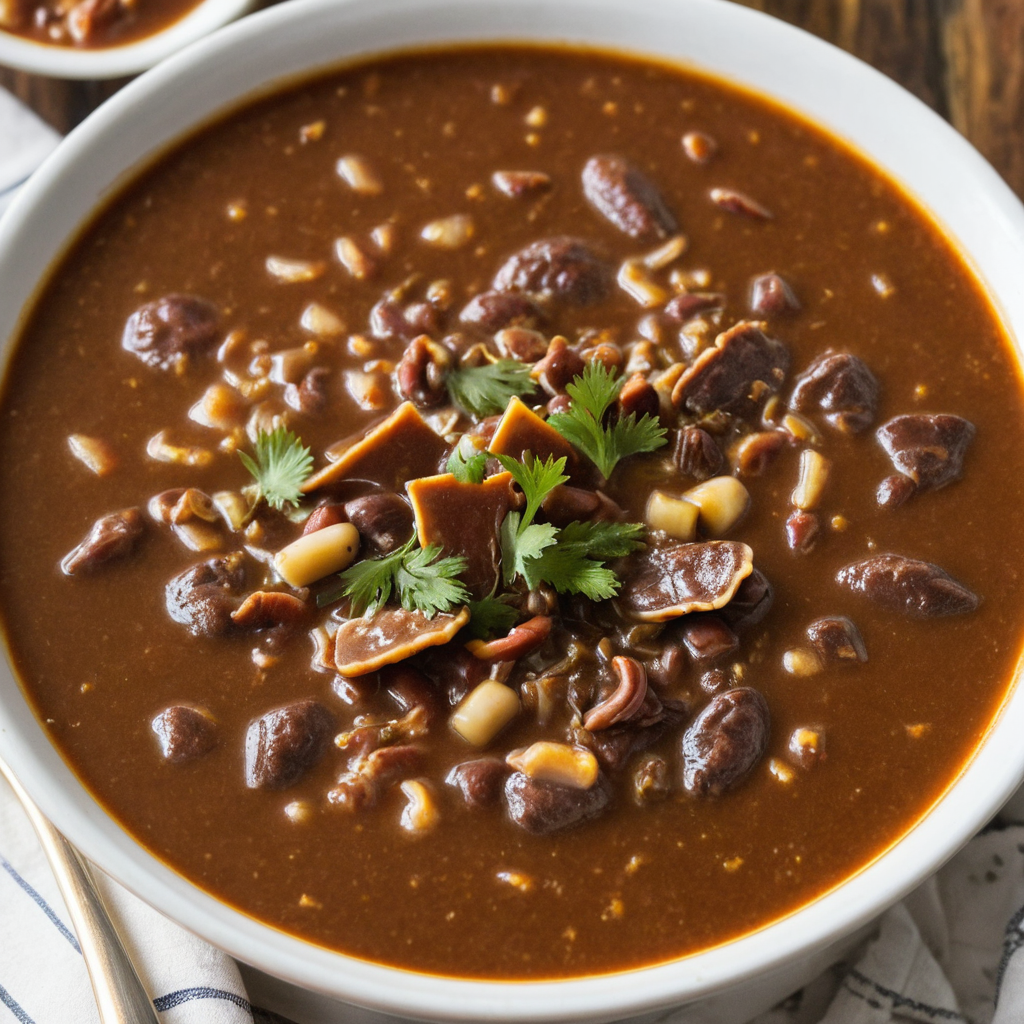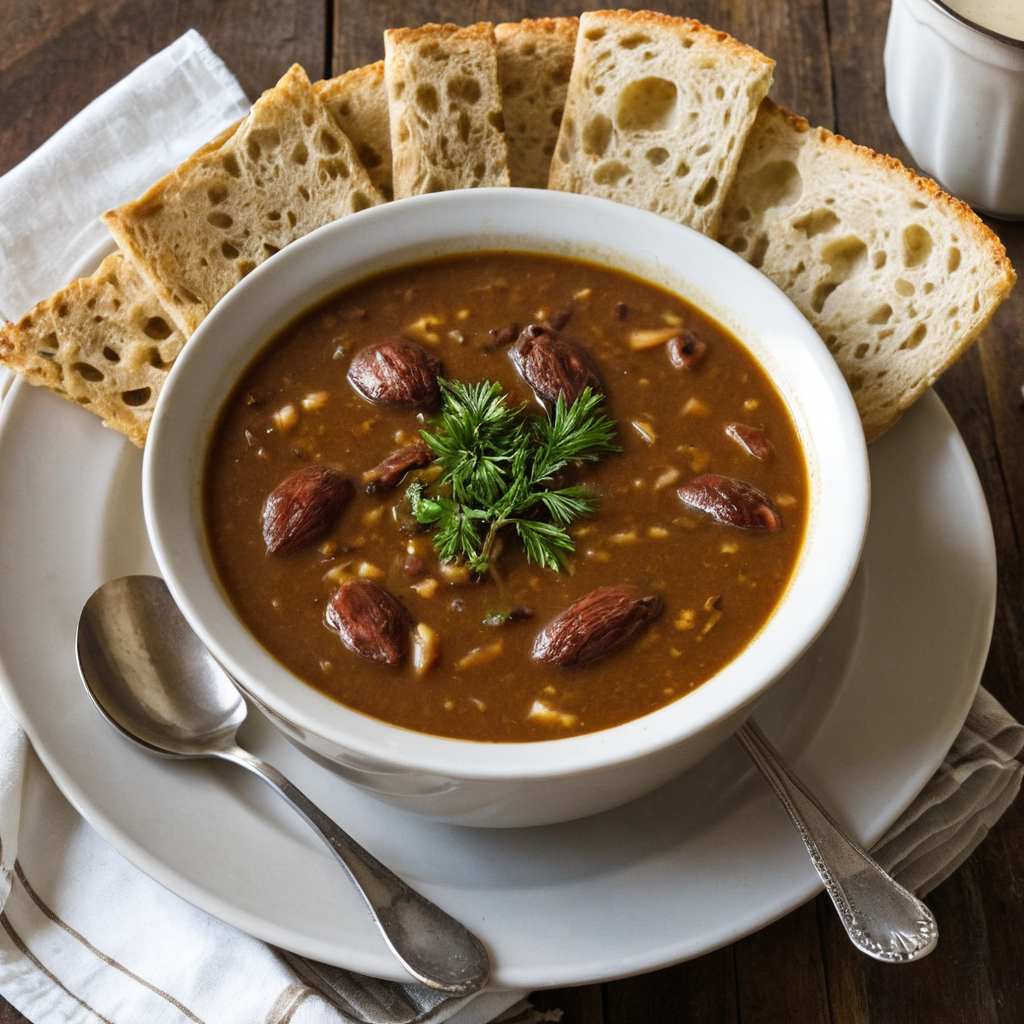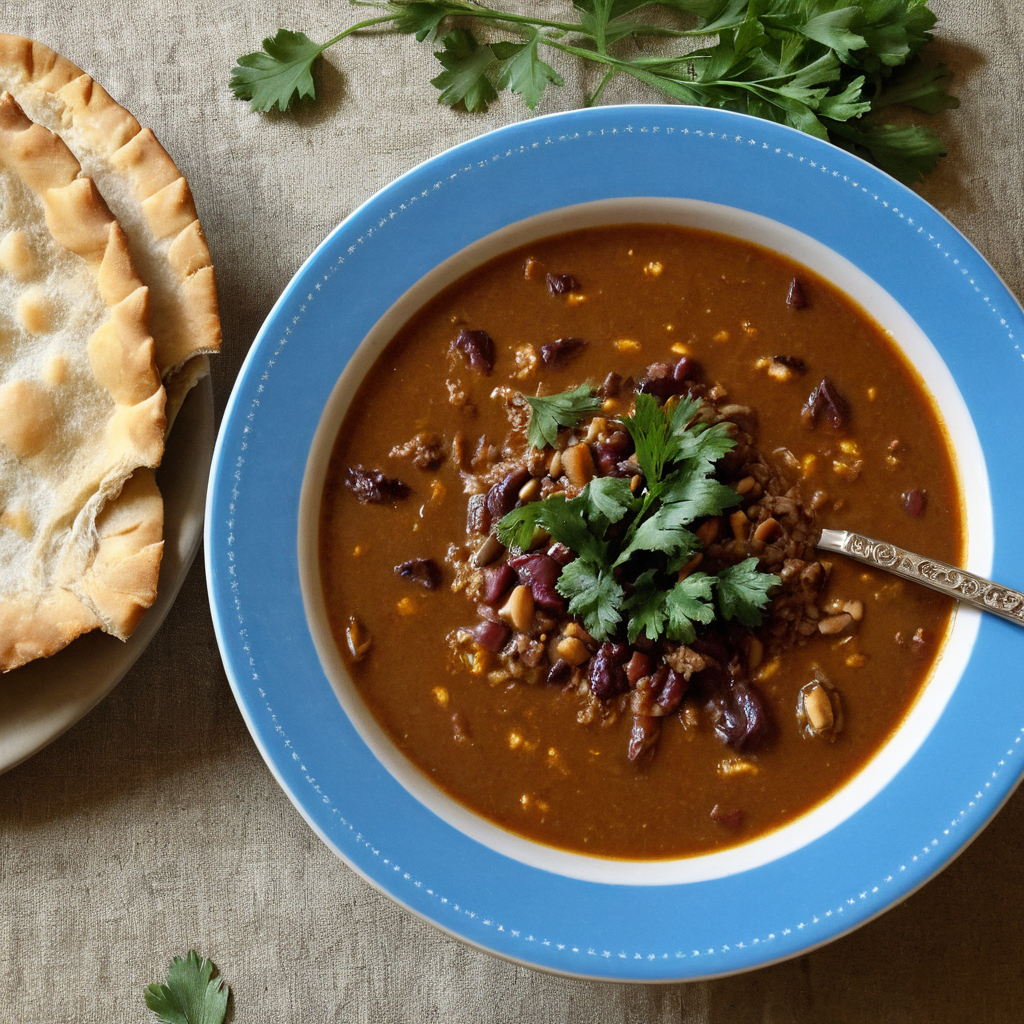Introduction
Mock Turtle Soup is a flavorful dish with a rich history. Despite its name, it doesn’t contain any turtles but instead mimics the taste and texture of traditional turtle soup. The “mock” refers to the soup’s origin as a less expensive alternative to the luxurious turtle-based soups popular among the wealthy in the 18th and 19th centuries.
What is Mock Turtle Soup?
Mock Turtle Soup is a hearty dish that originated in England and gained popularity in the United States, especially in the 19th century. The soup imitates the more expensive green turtle soup, once considered a delicacy for the elite. Instead of turtle meat, it uses affordable ingredients like beef, veal, or lamb.
The soup’s key elements include a rich, savory broth with ingredients that recreate the taste and texture of traditional turtle soup. It typically gets thickened with eggs and breadcrumbs and features hard-boiled eggs along with a tangy, flavorful broth spiced with thyme, bay leaves, and pepper. The dish stands out for capturing the richness of turtle soup while remaining budget-friendly.

Why It’s Called “Mock” Turtle Soup
The term “mock” refers to the soup’s role as an imitation of traditional turtle soup, which was once a luxurious dish. As turtle populations dwindled and the meat became scarce, cooks sought ways to replicate its flavor using more accessible ingredients. They replaced turtle meat with beef, veal, or lamb, adding seasonings and vegetables to achieve a similar taste. Over time, this alternative became known as “Mock Turtle Soup.”
Traditional Ingredients and Preparation
Mock Turtle Soup uses accessible ingredients to recreate the rich texture and savory taste of turtle soup. The main ingredients include veal, beef, or lamb, which cooks into a deep, gelatinous stock. In some traditional recipes, chefs add calf’s head, particularly the tongue and cheeks, for extra richness, though modern versions typically exclude it.
Hard-boiled eggs are essential for providing richness and a hearty texture that mimics turtle meat. Vegetables like onions, carrots, and celery sauté in butter, creating a base that balances the broth’s richness.
Herbs and spices like bay leaves, thyme, and peppercorns contribute the soup’s aromatic depth. To thicken it, breadcrumbs and beaten eggs are added, creating a velvety consistency. A splash of lemon juice or vinegar adds acidity, and some recipes call for sherry or Madeira wine to enhance the flavor with a hint of sweetness.
Prepare the Stock
Start by creating a rich meat stock. Cut veal, beef, or lamb into chunks and place them in a large stockpot. Add water, onions, carrots, celery, and bring to a boil. Lower the heat and simmer for several hours to extract maximum flavor. Skim the foam to keep the broth clear. Strain the stock, discarding the bones and vegetables, and keep the liquid.
Cook the Meat
While the stock simmers, brown the meat in butter or oil in a separate pot. Once browned, cut the meat into small pieces. If using calf’s head or oxtail, separate the tender bits from the bones and discard any inedible parts.
Sauté Vegetables
Sauté onions, carrots, and celery in butter until soft and fragrant. These vegetables provide natural sweetness that balances the rich broth.
Combine and Simmer
Add the strained stock and cooked meat to the sautéed vegetables. Season with bay leaves, thyme, peppercorns, and any additional spices. Simmer for 30–45 minutes to meld the flavors.
Thicken the Soup
Whisk together breadcrumbs and eggs, then slowly stir this mixture into the soup to create a creamy, velvety texture. Add just enough to thicken the soup without losing its broth-like consistency.
Finish the Soup
Before serving, stir in chopped hard-boiled eggs, a splash of lemon juice or vinegar, and optional sherry or Madeira wine. Taste and adjust seasoning with salt and pepper. Serve hot, garnished with extra eggs or parsley, if desired.
Regional Variations of Mock Turtle Soup
While the traditional recipe, remains popular across many parts of the United States, it has also evolved into different regional versions. These variations showcase local ingredients and culinary preferences, resulting in unique twists on the classic dish. Let’s explore some of the most notable regional adaptations.
Southern Mock Turtle Soup
In the Southern United States, Mock Turtle Soup is often prepared with a particular emphasis on depth of flavor and richness. The use of oxtail or shank cuts of beef is common, as these cuts of meat impart a gelatinous texture and meaty richness to the broth. Southern cooks may also include a variety of local vegetables, such as okra or tomatoes, which add a unique Southern flair to the dish.

Another distinctive feature of Southern Mock Turtle Soup is the inclusion of Cajun or Creole spices. Seasonings like Cajun seasoning, paprika, garlic, and onion powder may be added to the broth, giving the soup a slightly spicy, smoky undertone that contrasts beautifully with the richness of the meat and eggs. Some variations also include hot sauce on the side for added heat, allowing diners to customize the spice level to their liking.
Sherry or Madeira wine is often added at the end, providing a slight sweetness that complements the savory elements of the soup. The result is a deeply flavorful, comforting bowl of soup that embodies the spirit of Southern cooking.
New England Mock Turtle Soup
In New England, Mock Turtle Soup takes a slightly different approach, often using veal or beef as the primary meat. The dish tends to have a cleaner, less spicy profile, with a focus on the natural flavors of the meat and stock. Celery, carrots, and onions remain standard, but the use of bay leaves, thyme, and parsley helps accentuate the soup’s herbaceous qualities.

A notable feature of New England-style Mock Turtle Soup is the addition of cream or butter towards the end of cooking. This creates a richer, silkier texture, making the soup feel more luxurious. Hard-boiled eggs are still added, but they may be served in larger pieces or even as whole eggs, providing a more substantial bite.
The seasoning tends to be milder than in the Southern versions, focusing on fresh herbs and a touch of vinegar or lemon juice to balance out the richness of the broth. New England-style Mock Turtle Soup is often served with crusty bread or biscuits, perfect for soaking up the delicious, velvety broth.
Midwestern Mock Turtle Soup
In the Midwest, Mock Turtle Soup can be somewhat simpler but no less satisfying. Midwestern cooks often use beef or veal as the primary meat and prefer a clear, rich broth without the added thickness of breadcrumbs or eggs. The focus is on the beefy richness, often supplemented by a beef bone broth or oxtail stock to create a more gelatinous base.

The vegetables used in the Midwest version of the soup are typically onions, celery, and carrots, but there may also be a subtle inclusion of potatoes to add body to the soup. Rather than using wine or cream, Midwestern Mock Turtle Soup often relies on a simple vinegar or lemon juice to provide a tangy balance to the richness.
A unique twist in some Midwestern variations includes the use of Worcestershire sauce to deepen the flavor, while others might add a hint of sugar to round out the savory profile. Midwestern versions are often served as a starter in a multi-course meal, emphasizing both comfort and simplicity.
Modern and Creative Twists on Mock Turtle Soup
As with any classic dish, Mock Turtle Soup has inspired numerous modern adaptations. Chefs and home cooks alike have embraced the tradition while experimenting with new flavors, techniques, and dietary preferences. Here are some contemporary twists that bring a fresh perspective to the traditional recipe.
Gluten-Free Mock Turtle Soup
For those who require gluten-free options, it’s easy to adapt the Mock Turtle Soup recipe by simply substituting traditional breadcrumbs with gluten-free breadcrumbs or cornmeal. Additionally, using gluten-free flour to thicken the broth ensures that the soup retains its signature smooth consistency without the use of wheat products.
Many cooks also add extra vegetables, such as zucchini or spinach, to boost the nutritional value of the soup without compromising on taste. Some versions use a beef or chicken stock as the base, while others may go for a vegetable broth, ensuring that everyone can enjoy this comforting dish.
Nutritional Benefits of Mock Turtle Soup
Mock Turtle Soup, depending on the version you choose to make, offers a range of nutritional benefits. It can be an excellent source of protein, particularly when made with beef, veal, or even plant-based alternatives. Here’s a breakdown of some of the key nutrients and benefits that come with this delicious soup:
- Protein
The primary source of protein in Mock Turtle Soup comes from the meat or plant-based proteins used in the recipe. For meat-based versions, cuts like veal, beef, and lamb offer a hearty dose of protein, which is essential for muscle growth, repair, and overall body function. Vegan versions that use ingredients like tofu, tempeh, and mushrooms also provide a plant-based protein that is beneficial for those on vegetarian or vegan diets. - Vitamins and Minerals
The soup’s vegetables, including carrots, celery, and onions, are packed with essential vitamins and minerals. For instance, carrots provide a high dose of vitamin A, which supports vision and immune health, while celery is rich in vitamin K and potassium, which are crucial for bone health and heart function. The hard-boiled eggs in traditional versions offer vitamin B12 and iron, essential for energy production and red blood cell formation. - Healthy Fats
When made with beef or veal, Mock Turtle Soup also provides a modest amount of healthy fats. While it can be rich in saturated fat, using lean cuts of meat can help reduce the fat content. For those opting for plant-based recipes, avocado or olive oil can be used for a healthy dose of monounsaturated fats, which are good for heart health.
Frequently Asked Questions about Mock Turtle Soup
What is Mock Turtle Soup?
Mock Turtle Soup is a rich, savory dish originally created as a substitute for the more expensive green turtle soup. The “mock” refers to the use of veal, beef, or lamb instead of turtle meat. The soup typically features a hearty broth, vegetables like onions, carrots, and celery, along with hard-boiled eggs, breadcrumbs, and seasonings. While recipes vary, it maintains a rich, savory, and slightly tangy flavor with a creamy texture.
Can Mock Turtle Soup Be Made Without Meat?
Yes, the soup can be made without meat for vegetarians or those seeking a plant-based version. Meat alternatives such as tofu, tempeh, or jackfruit mimic the texture of meat, and vegetable stock replaces the meat-based broth. Mushrooms or lentils provide umami flavor, and eggs or dairy can be replaced with vegan alternatives.
Key Ingredients in Mock Turtle Soup
- Meat: Often veal, beef, or lamb, sometimes oxtail or calf’s head.
- Vegetables: Onions, carrots, celery, and occasionally tomatoes or okra.
- Hard-boiled eggs: For richness and texture.
- Breadcrumbs: Used as a thickening agent.
- Herbs and spices: Bay leaves, thyme, black pepper, with a splash of vinegar or lemon juice.
- Wine: Sometimes dry sherry or Madeira is added for depth.
How Long Does It Take to Make Mock Turtle Soup?
Mock Turtle Soup typically takes 3 to 4 hours to prepare: 2 to 3 hours to simmer the stock, 30 to 45 minutes to cook the soup, and an additional 10 to 15 minutes for thickening and final adjustments.
Can I Use Canned Turtle Meat in Mock Turtle Soup?
While canned turtle meat is less common and expensive today, it can be used in place of veal or other meats if available, but it’s not essential for a traditional mock version.
Conclusion
Mock Turtle Soup is a classic dish that has evolved over centuries, offering a satisfying and comforting culinary experience. Created as a more affordable alternative to traditional turtle soup, it has been adapted across regions with various versions to suit local tastes and modern diets.

